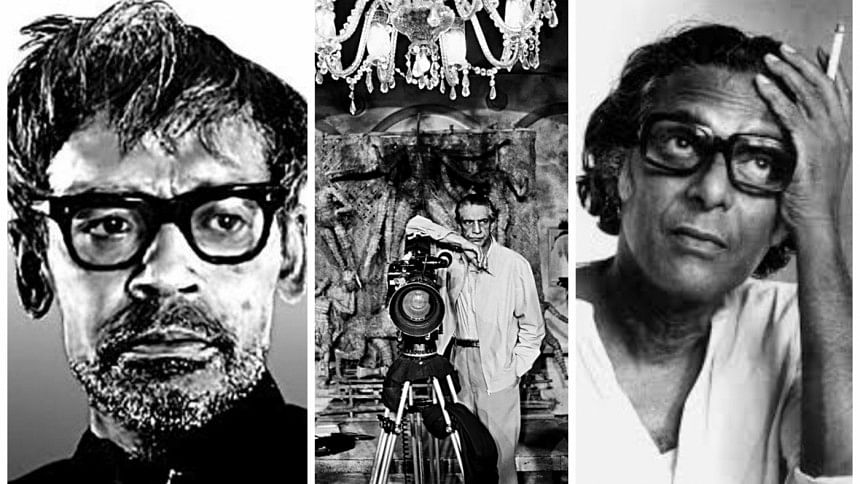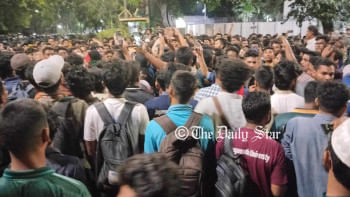Political films in Bengali: The legacy of Satyajit, Ritwik, and Mrinal

The first anthology film of Bangladesh which features eleven different stories from eleven different directors, titled "Iti, Tomari Dhaka" (Sincerely yours, Dhaka) landed on Netflix shortly after its release in the theatres. While each of the eleven stories in this widely acclaimed film revolves around the lives of people from diverse spheres in Dhaka, there is one particular story that caught everyone's attention differently. "Jinnah Is Dead", directed by Krishnendu Chattopadhyay is based on the lives of the Bihari community living in a Geneva Convention Camp in Dhaka. While "Jinnah Is Dead" is a story that focuses on the marginalised lives of the residents of the Bihari refugee camps and their struggles for survival, its essence is that it depicts the identity crisis of such a man coming from the refugee camp who makes his way into the Bengali society, but cannot let go of his roots altogether. This identity crisis and the indication of this man's inclinations towards the ideology of Jinnah is what essentially makes this story a political one. This sort of narrative is not something we see in our movies every now and then, given that very few films have been made in our country that are truly political in nature.
A political film can be described as an instrument that kindles consciousness in the viewer about the injustice and exploitation prevailing in society. The making of a political film depends on the freedom of expression that a filmmaker has. Political films can be differentiated from purely historical films in the sense that political films make way for self-criticism of the viewer. It essentially differs from a propaganda film, because it involves taking a stance, which usually implies standing with the oppressed. In that sense, two movies produced in Bangladesh stand successful in being truly political, Zahir Raihan's "Jibon Theke Newa", released before the independence of the country and set in the background of the language movement in 1952 and Tareque Masud's "Matir Moyna" (The Clay Bird) released in 2002, which was long after the country's independence, but set in the 1960s, a turbulent time when the people of the then East Pakistan were starting to discover a cultural identity of their own amidst the prevailing religious dogmatism. Both of these filmmakers, though they belonged at different times were successful in making political films because of their unique forms, techniques, and way of story-telling. These two very uniquely talented filmmakers could take the art of political films to newer heights if it were not for their untimely demises. But three names have truly contributed to establishing political films in the Bengali cinemas: Satyajit Ray, Ritwik Ghatak and Mrinal Sen.
Satyajit Ray changed the perception about Bengali films in the international arena with his debut film "Pather Panchali" in 1955. In the later years of his filmmaking career, after the tremendous success of his famous "Apu trilogy" and other literary adaptations, his interests started inclining towards films with stronger political statements. He made films like "Pratidwandi" (1970), "Sheemabaddha" (1971) and Jana Aranya (1975), which were set against the backdrop of the then Kolkata, and condemned the prevailing crises that the city and the state as a whole were caught within, such as bureaucratic corruption, political hypocrisy and the conformist way of thinking by the masses and the educated middle class. According to Ray, the one-man protest depicted in "Pratidwandi" could be stronger than the combined efforts of the Naxalite movement. In 1980, "Hirok rajar Deshe", a political satire made by Ray, sequel to "Goopy Gyne Bagha Byne" (1968) was released. This film depicted the conflict between creative and enlightened individuals and an oppressive monarchy. Many consider this film to be a strong criticism and condemnation of the Indira Gandhi regime for imposing a state emergency in India in 1975. This legendary cinema remains relevant to this day while discussing state oppression or injustice. A very recent political satire film in Kolkata titled "Bhooter Bhobishshot" (2012) is said to be directly influenced by "Hirok Rajar Deshe" by many. Later on, Ray made "Ganashutru" (1989), a movie that addressed and condemned religious dogmatism. Ray's political films always ended with an optimistic note, shining a ray of hope although an exception of this was made in "Jana Aranya".
Ritwik Ghatak was another pioneering figure of Bengali political films. He only directed eight feature films in his entire career. His trilogy consisting of "Meghe Dhaka Tara", "Komal Gandhar" and "Subarnarekha" showed the price of independence from the British colonial lords with the agony of partition in Bengal, through the story of a refugee camp. According to Ghatak, cinema to him was a means of expressing his anger and frustration at the sorrows and sufferings of the people. One interesting fact about this trilogy is that the stories largely depend on the point of view of the female protagonists while showing the severity of the refugee crisis. "Jukti, Tokko Aar Goppo", his last film, was set against the backdrop of the Naxalite movement in West Bengal. This film questioned the then political scenario through a narrative style that was successful in shocking the viewers and making them uncomfortable and self-critical, thus serving the purpose of a political film with great success.
The Calcutta trilogy by Mrinal Sen is considered to be one of the most prolific works in Bengali political cinema. The trilogy consists of "Interview" (1970), "Calcutta 71" (1972) and "Podatik" (1973). Set in the background of the Naxalite movements of West Bengal in the 70s, the three films capture three different angles. The first one captures the colonial norms posing as an obstacle for the growth and development of the middle class while the second one captures the harsh reality of poverty and exploitation. And finally, the third one captures the critical angles of the Naxalite movement through the lens of a young Naxalite. The third one created a lot of controversy among both the supporters of the left and the right wings, stirring heated debate against the film from both sides. But according to Sen, it was important to raise these issues no matter how controversial they were, because if there was something wrong about the process of a movement, it needed to be figured out.
If we believe that this discussion is confined within Bangladesh only, what we need to remember while emphasising the need to patronise more political films is that in a society that is still suffering from the wounds of colonisation and oppression, cinema can act as the most important art form that can make people self-aware and self-critical, and enable them to take a stance against the prevailing inequality. Political films can be crucial in fighting oppression and gaining freedom of speech and expression. And the young artists of the country, who are gradually moving away from the practice of staying apolitical can always draw inspiration from the works of Ray, Ghatak, and Sen.
References:
https://www.cineaste.com/winter2018/understanding-my-times-mrinal-sen?fbclid=IwAR2VE5YQiuIJAulWrS50qfaBT4LudkK3-LVEN8Kwf0MDsZf6u7yQHmHOIvg
https://www.ejumpcut.org/archive/onlinessays/jc12-13folder/MrinalSen.html?fbclid=IwAR1wS8WM6kGfaYNifrJBWthqe58jJKO5kRbSIAXqSVqg_nfSPVa42WxpJz4
https://theprint.in/features/ritwik-ghatak-the-celluloid-rebel-who-used-cinema-as-a-political-tool/144631/?fbclid=IwAR2AljOq2urPLZXPyXQm4LDX-PDVQHUR71vw08UBog9PeZ4WRSWpQR66H9w

 For all latest news, follow The Daily Star's Google News channel.
For all latest news, follow The Daily Star's Google News channel. 



Comments